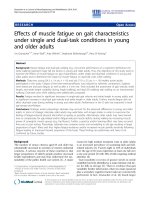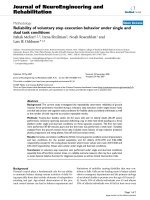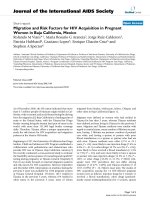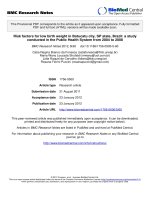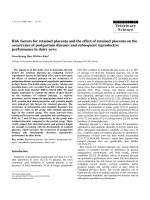Gait parameter risk factors for falls under simple and dual task conditions in cognitively impaired older people
Bạn đang xem bản rút gọn của tài liệu. Xem và tải ngay bản đầy đủ của tài liệu tại đây (180.25 KB, 5 trang )
Gait & Posture 37 (2013) 126–130
Contents lists available at SciVerse ScienceDirect
Gait & Posture
journal homepage: www.elsevier.com/locate/gaitpost
Gait parameter risk factors for falls under simple and dual task conditions in
cognitively impaired older people
Morag E. Taylor a,b,**, Kim Delbaere a,c, A. Stefanie Mikolaizak a, Stephen R. Lord a,c,
Jacqueline C.T. Close a,b,*
a
b
c
Falls and Balance Research Group, Neuroscience Research Australia, Sydney, Australia
Prince of Wales Clinical School, University of New South Wales, Sydney, Australia
School of Public Health and Community Medicine, University of New South Wales, Sydney, Australia
A R T I C L E I N F O
A B S T R A C T
Article history:
Received 13 December 2011
Received in revised form 25 May 2012
Accepted 26 June 2012
Impaired gait may contribute to the increased rate of falls in cognitively impaired older people. We
investigated whether gait under simple and dual task conditions could predict falls in this group. The
study sample consisted of 64 community dwelling older people with mild to moderate cognitive
impairment. Participants walked at their preferred speed under three conditions: (a) simple walking, (b)
walking while carrying a glass of water and (c) walking while counting backwards from 30.
Spatiotemporal gait parameters were measured using the GAITRite1 mat. Falls were recorded
prospectively for 12 months with the assistance of carers. Twenty-two (35%) people fell two or more
times in the 12 month follow-up period. There was a significant main effect of gait condition and a
significant main effect of faller status for mean value measures (velocity, stride length, double support
time and stride width) and for variability measures (swing time variability and stride length variability).
Examination of individual gait parameters indicated that the multiple fallers walked more slowly, had
shorter stride length, spent longer time in double support, had a wider support width and showed more
variability in stride length and swing time (p < 0.05). There was no significant interaction between gait
condition and faller status for any of the gait variables. In conclusion, dual task activities adversely affect
gait in cognitively impaired older people. Multiple fallers performed worse in each gait condition but the
addition of a functional or cognitive secondary task provided no added benefit in discriminating fallers
from non-fallers with cognitive impairment.
ß 2012 Elsevier B.V. All rights reserved.
Keywords:
Gait
Dementia
Cognition
Accidental falls
Dual task
1. Introduction
Cognitive impairment and dementia are known risk factors for
falls [1], and the incidence of falls in older people with cognitive
impairment (60% per annum) is approximately double that of their
cognitively intact counterparts. Underlying mechanisms for this
increased risk are poorly understood and gait dysfunction may
play an important role.
Whilst considered primarily an automated motor process, there
is evidence to support the involvement of higher level cognitive
processes in the gait cycle [2,3]. The simultaneous performance of
an attention-demanding task while walking often results in
changes in gait patterns, which is interpreted as interference
* Corresponding author at: Neuroscience Research Australia, Barker Street,
Randwick, NSW 2031, Australia. Tel.: +61 293991055; fax: +61 293991204.
** Co-corresponding author at: Neuroscience Research Australia, Barker Street,
Randwick, NSW 2031, Australia. Tel.: +61 293991060; fax: +61 293991204.
E-mail addresses: (M.E. Taylor),
(Jacqueline C.T. Close).
0966-6362/$ – see front matter ß 2012 Elsevier B.V. All rights reserved.
/>
caused by competing demands for limited resources [2,3]. Gait
changes related to the addition of a secondary task have been
associated with falls in cognitively intact older adults [4–8].
Gait disorders including increased gait variability are common
in people with cognitive impairment and dementia [9–16] and
dual task activities have been shown to detrimentally affect gait in
people with these conditions [10–14,16–19]. Three studies have
examined gait and prospective falls in older people with dementia
under simple walking conditions. In older people with dementia
living in residential care, velocity, cadence, stride length, double
support time variability, heel-to-heel base of support variability
and stride length variability were important in discriminating
between fallers and non-fallers [20–22].
To date, no studies have examined whether dual task gait
abnormalities are associated with falls in community dwelling
cognitively impaired older people or whether the addition of the
secondary task provides additional benefit in discriminating fallers
from non-fallers with this condition. The current study, therefore,
investigated whether poor gait performance under simple,
functional and cognitive dual task conditions increases the risk
M.E. Taylor et al. / Gait & Posture 37 (2013) 126–130
of falls in community dwelling older adults with cognitive
impairment.
2. Methods
2.1. Participants
Sixty-four cognitively impaired participants were recruited from a number of
routine health service settings, community services and advertisements in the local
press. Participation was dependent on (i) having an age 60 years or above, (ii) living
in the community and (iii) having an identified and willing ‘‘person responsible’’
with at least 3.5 h of face to face contact per week. Cognitive impairment was
defined as a Mini-Mental State Examination (MMSE) < 24, Addenbrooke’s
Cognitive Examination – revised (ACE-R) < 83 [23] or where a specialist clinician
had made a diagnosis of cognitive impairment or dementia. Exclusion criteria
included recent stroke (within 18 months), progressive neurodegenerative
disorders (excluding dementia), insufficient English to complete the tasks or
known end stage illness. The study was approved by the South East Sydney Human
Research Ethics Committee and consent was obtained from all participants and
their person responsible prior to assessment.
2.2. Assessment
Participants and their person responsible were initially assessed in their home
environment with information obtained on demographics, medical and medication
history and functional performance.
Consenting participants attended the gait laboratory for the gait assessment.
Temporal and spatial gait parameters were measured with the GAITRite1 mat
(CIR Systems Inc., Clifton, NJ, USA). The standard GAITRite1 system is a 460 cm
mat with an active area of 2.23 m2 containing 13,824 pressure sensors arranged
in a grid pattern with a spatial resolution of 1.27 cm and a sampling frequency
of 80 Hz. Gait parameters were obtained from GAITRite Gold Software Version
3.3.
Participants performed six trials on the GAITRite1 mat, wearing comfortable
footwear, at their preferred walking speed and with their usual walking aid in a
well lit and quiet room. Three gait conditions were assessed, each with two trials;
(i) simple walking, (ii) walking while carrying a glass of water in the participants
preferred hand (filled to 10 mm from rim) (Functional dual task) and (iii) walking
while counting backwards from 30 (Cognitive dual task). Two participants who
mobilised with a walking frame did not perform the functional dual task.
Participants started one and a half metres before the GAITRite1 mat and were
instructed to walk beyond the mat completing a further one and half metres. They
were instructed to concentrate equally on their walking and functional/cognitive
activity under dual task conditions. Two research assistants were present for all
gait assessments. Footfall data were recorded by the computerised walkway with
manual correction of footfall labelling completed where necessary. Seven gait
variables were calculated using the mean of two trials; velocity (cm/s), cadence
(steps/min), stride length (cm), double support time (s), stride width (cm),
coefficient of variation of stride length (%) and coefficient of variation of swing
time (%). The coefficient of variation (CoV) is a measure of variability and
is expressed as the percentage of the ratio of the standard deviation to the
mean. Dual task cost was calculated for each gait variable under both dual
task conditions. These measures were chosen as they have previously been
reported in the literature in relation to gait in cognitively impaired people
[3,9,15,17,18,20,21].
127
2.3. Falls follow-up
Monthly falls calendars and reply paid envelopes were given to the participants/
carers to ensure accurate data collection with regard to falls. The fall definition
articulated to the participant and carer was, ‘‘In the past month, have you had any
falls including a slip or a trip in which you lost your balance and landed on the floor
or ground or lower level?’’ [24]. If a participant/carer failed to return a calendar, a
telephone call was made to the carer/person responsible to obtain the participant’s
falls data. A multiple faller was defined as someone who fell at least twice during
the 12 month follow-up period.
2.4. Statistical analysis
Data were analysed using SPSS 18.0 for Windows (SPSS, Inc., Chicago, IL).
Coefficient of variation (CoV = SD/mean  100) was calculated for stride length
(stride length variability) and swing time (swing time variability); the CoV for each
trial was calculated and the mean of two trials is reported. For variables with
skewed distributions, data were log normalised. Data on double support time,
swing time, stride length variability and swing time variability were normalised
using logarithmic transformations for all conditions. Extreme scores were censored
at a level of 3SD from the mean and were included in the analyses i.e. for one case for
the following variables: simple double support time, functional dual task swing
time variability and stride length variability, cognitive dual task double support
time and stride length variability; and for two cases for functional dual task swing
time variability. All parametric analyses were performed with the transformed
data. Univariate analyses were carried out using independent sample t-tests and
Chi squared tests for cross-tabulation tables to compare non-multiple fallers and
multiple fallers’ demographic and medical characteristics. Data for each gait
variable were analysed using repeated measures multivariate ANOVA with gait
condition (simple vs functional vs cognitive) as the within-subject factor and faller
status (0–1 vs 2+) as the between-subject factor. Spatiotemporal gait measures and
gait variability measures were analysed separately. DTC was calculated for each
variable for both functional and cognitive dual task conditions: Dual Task
Cost = ([dual task À simple]/simple) Â 100.
3. Results
Falls data were available for 63 of the participants; one
participant was lost to follow-up. Thirty-four (54%) participants
reported falls in the 12 month follow-up period, with 22 (35%)
reporting multiple falls (!2). The demographic and medical
characteristics of the non-multiple fallers and multiple fallers
are shown in Table 1.
The spatiotemporal gait parameters under the three conditions
and the dual task cost for non-multiple fallers and multiple fallers
are displayed in Table 2.
3.1. Effects of dual task condition
Thirty-three participants (51.6%) made an iteration error while
counting backwards and walking. Five (7.8%) of 64 were unable to
Table 1
Participant characteristics: displaying p values for univariate analysis.
Characteristic
Non-multiple fallers (<2) (n = 41)
Multiple fallers (!2) (n = 22)
p value
Age, mean Æ SD
Female, n (%)
Height (m), mean Æ SD
Weight (kg), mean Æ SD
Fall in the past year, n (%)
Walking aid use, n (%)
Education (years), mean Æ SD
MMSE, mean Æ SD
ACE-R, mean Æ SD
Heart problems, n (%)
Hypertension, n (%)
Cholesterol, n (%)
Stroke, n (%)
Diabetes, n (%)
Arthritis, n (%)
Osteoporosis, n (%)
Number of medications, mean Æ SD
Psychoactive medication, n (%)
80.7 Æ 6.8
19 (46.3)
1.65 Æ 9.72
66.6 Æ 12.9
16 (39.0)
8 (19.5)
10.5 Æ 3.1
24.8 Æ 3.6
72.1 Æ 10.7
13 (31.7)
19 (46.3)
19 (46.3)
2 (4.9)
6 (15.0)
23 (57.5)
8 (21.0)
5.6 Æ 3.3
12 (29.3)
82.5 Æ 6.9
10 (45.5)
1.63 Æ 6.97
69.1 Æ 14.1
19 (86.4)
6 (27.3)
9.6 Æ 2.4
22.7 Æ 5.1
66.4 Æ 13.7
13 (59.1)
16 (72.7)
13 (59.1)
3 (13.6)
6 (27.3)
14 (63.6)
4 (18.2)
7.6 Æ 3.3
7 (31.8)
0.310
0.946
0.368
0.464
<0.001
0.480
0.868
0.076
0.074
0.035
0.045
0.335
0.220
0.242
0.637
0.862
0.036
0.833
Notes: MMSE, Mini-Mental State Examination, ACE-R, Addenbrooke’s Cognitive Examination Revised.
M.E. Taylor et al. / Gait & Posture 37 (2013) 126–130
128
Table 2
Means and standard deviations of spatiotemporal gait parameters and dual task cost for non-multiple fallers and multiple fallers: univariate analysis comparing mean scores
of non-multiple fallers and multiple fallers.
Gait parameters
Velocity (cm/s)
Simple
Functional dual task
Cognitive dual task
Cadence (steps/min)
Simple
Functional dual task
Cognitive dual task
Stride length (cm)
Simple
Functional dual task
Cognitive dual task
Double support time (s)
Simple
Functional dual task
Cognitive dual task
Stride width (cm)
Simple
Functional dual task
Cognitive dual task
Stride length variability (CoV)
Simple
Functional dual task
Cognitive dual task
Swing time variability (CoV)
Simple
Functional dual task
Cognitive dual task
Non-multiple fallers (<2) (n = 41)
p value*
Multiple fallers (!2) (n = 22)
Spatiotemporal measures
(mean Æ SD)
Dual task cost (%)
Spatiotemporal measures
(mean Æ SD)
Dual task cost (%)
94.25 Æ 23.60
84.98 Æ 23.28
78.67 Æ 27.15
n/a
À11.02 Æ 13.71
À17.04 Æ 18.76
78.96 Æ 29.69
68.56 Æ 28.59
61.16 Æ 28.39
n/a
À15.69 Æ 15.28
À23.64 Æ 17.16
0.038
0.020
0.024
101.30 Æ 12.47
98.07 Æ 12.34
88.69 Æ 17.41
n/a
À3.49 Æ 8.86
À12.20 Æ 15.05
96.03 Æ 15.74
93.04 Æ 16.63
82.48 Æ 20.71
n/a
À4.31 Æ 8.58
À15.26 Æ 13.49
0.225
0.191
0.230
111.15 Æ 22.53
103.10 Æ 22.54
104.50 Æ 24.63
n/a
À8.16 Æ 8.42
À6.28 Æ 9.94
97.05 Æ 25.55
86.45 Æ 25.47
87.20 Æ 25.28
n/a
À12.28 Æ 9.89
À9.76 Æ 12.69
0.027
0.012
0.014
0.29 Æ 0.07
0.34 Æ 0.11
0.39 Æ 0.22
n/a
17.69 Æ 25.96
32.68 Æ 52.43
0.37 Æ 0.15
0.43 Æ 0.17
0.55 Æ 0.32
n/a
22.22 Æ 25.69
42.97 Æ 36.75
0.029
0.021
0.027
12.85 Æ 3.31
13.06 Æ 3.28
13.43 Æ 3.55
n/a
3.18 Æ 14.27
5.16 Æ 14.37
14.33 Æ 3.47
14.90 Æ 3.39
15.44 Æ 3.79
n/a
5.18 Æ 16.27
8.73 Æ 14.77
0.082
0.048
0.028
2.63 Æ 1.62
3.17 Æ 2.05
3.74 Æ 2.83
n/a
38.31 Æ 89.31
64.61 Æ 130.01
4.20 Æ 2.54
5.76 Æ 4.66
6.34 Æ 5.03
n/a
50.38 Æ 119.96
68.43 Æ 146.57
0.009
0.027
0.009
6.25 Æ 3.39
6.74 Æ 5.30
9.42 Æ 7.31
n/a
29.50 Æ 131.39
128.97 Æ 493.20
8.07 Æ 4.37
10.65 Æ 7.67
15.06 Æ 11.25
n/a
50.41 Æ 89.55
141.62 Æ 341.19
0.139
0.017
0.019
Dual task cost = ([dual task À simple]/simple)  100, CoV = Coefficient of variation (CoV = SD/mean  100). A higher score represents better performance: Velocity, cadence and
stride length. A higher score represents worse performance: Double support time, stride width, stride length variability and swing time variability. Functional dual task: two
participants were unable to perform as they mobilised with a walking frame. Cognitive dual task: one person declined to attempt, three counted forwards as they were unable
to count backwards and walk and one walked off the mat, data for one trial were used for this participant.
*
p value represents univariate analysis of spatiotemporal gait measures comparing non-multiple fallers to multiple fallers.
perform the secondary cognitive task and successfully walk; one
(1.6%) walked off the mat (one trial only), three (4.7%) could only
count forwards and one (1.6%) declined to attempt the task. Two
participants were unable to perform the functional task as they
walked with two hands holding a walking frame.
3.2. Gait parameters under simple and dual task conditions
A significant main effect of gait condition for mean value
(excluding cadence) (Wilks’ l = 0.292, F8,51 = 15.465, p < 0.001)
and variability (Wilks’ l = 0.741, F4,55 = 4.800, p = 0.002) measures
confirmed that participants altered their gait pattern under dual
task conditions. Univariate analyses showed that when compared
to the simple walking condition, participants walked with reduced
gait speed, cadence and stride length; and increased double
support time, stride width, swing time variability and stride length
variability while counting backwards (p < 0.01), and walked with
reduced gait speed, cadence and stride length; and increased
double support time and stride length variability while carrying a
glass of water (p < 0.05). When comparing the two dual task
conditions; participants walked with reduced gait speed and
cadence and; increased double support time, stride width and
swing time variability while counting backwards compared to
carrying a glass of water (p < 0.05).
3.3. Gait parameters in non-multiple and multiple fallers
A significant main effect of faller status for mean value
measures (excluding cadence) (Wilks’ l = 0.843, F4,55 = 2.564,
p = 0.048) and for variability measures (Wilks’ l = 0.850,
F2,57 = 5.017, p = 0.010) confirmed that multiple fallers had
different gait patterns across all test conditions. Examination of
individual gait parameters indicated that the multiple fallers
walked more slowly (p = 0.018), had shorter stride length
(p = 0.013), spent longer time in double support (p = 0.014), had
a wider support width (p = 0.038) and showed more variability in
stride length (p = 0.003) and swing time (p = 0.006). There were no
significant interactions between gait condition  faller status for
mean value measures (excluding cadence) (Wilks’ l = 0.915,
F8,51 = 0.595, p = 0.777) or variability measures (Wilks’ l = 0.965,
F4,55 = 0.502, p = 0.735) overall or individually (velocity: p = 0.813,
cadence: p = 0.908, stride length: p = 0.538, DST: p = 0.403, stride
width: p = 0.473, stride length variability: p = 0.826, swing time
variability: p = 0.438) suggesting that dual task offered no added
benefit compared to simple gait measurement.
4. Discussion
We have demonstrated that secondary tasks adversely affect
gait in community dwelling cognitively impaired older people. In
the present study, both simple and dual task spatiotemporal gait
measures were associated with falls in this high risk population.
Several studies have reported that undertaking a secondary task
adversely affects gait in both cognitively intact [3,6–8,10–
12,14,25–27] and cognitively impaired older adults [10–14,16–
19,28] with the extent of the dual task cost dependent on the
secondary task, the population studied and the instructions given
with regard to attention prioritisation [3,6,17,25,27–29]. A recent
study by Theill et al. found that cognitively impaired older people
have a greater reduction in gait velocity when performing a
secondary task (performing counting backwards by two and
animal fluency tasks) compared to their cognitively intact
M.E. Taylor et al. / Gait & Posture 37 (2013) 126–130
counterparts [28], suggesting that the dual task cost is greater in
this population. In our cohort of cognitively impaired older people,
both of the secondary tasks also resulted in substantially poorer
gait performance. Velocity and stride length variability had mean
dual task costs of À13% and 45% respectively for the functional task
condition and À20% and 73% respectively for the cognitive task
condition.
Some previous studies have shown that dual task gait
assessments are superior to standard assessments in discriminating between faller and non-faller groups in cognitively intact older
people [5,8]. However, other studies have found that dual task gait
assessment provides no additional discriminatory benefit over
standard assessments [4,7]. Only one previous study has examined
dual task gait and falls in cognitively impaired people. Camicioli
and Licis assessed the effect of one dual task walk in a population
with moderate to severe Alzheimer’s disease living in care facilities
[21]. Forward counting (from one) affected cadence in both fallers
and non-fallers similarly and did not discriminate between the
faller groups. Allali examined gait in older people with dementia
and frontal lobe dysfunction and found that stride time and stride
time variability increased more when participants counted
backwards compared to forwards [19], perhaps accounting for
why the secondary task in Camicioli and Licis’ cohort did not
discriminate between faller groups.
The current study findings are consistent with previous
research undertaken in older people with dementia living in
nursing homes [20–22] and indicate that a range of spatiotemporal
gait parameters (velocity, stride length and variability measures)
discriminate between multiple and non-multiple fallers. However,
the lack of significant faller status by gait condition interactions
indicate the dual task gait assessments provided no additional
benefit over standard gait assessments in discriminating between
non-multiple and multiple fallers in this population. These findings
have a number of clinical implications. Firstly, in terms of gait
assessment, simple assessments appear to be adequate for
assessing fall risk in cognitively impaired older people. Secondly,
increased fall risk within this group may be due more to
sensorimotor and balance impairments than cognitive deficits,
an assertion supported by the non-significant differences in MMSE
and ACE-R scores between the non-multiple and multiple faller
groups (Table 1). Accordingly, interventions for preventing falls in
this group may need to emphasise exercise programmes aimed at
enhancing gait stability, lower limb muscle strength and balance.
To our knowledge, this is the first study investigating dual task
gait and prospective falls in community dwelling cognitively
impaired older people. The prospective study design with rigorous
falls follow-up procedures was a major strength of this study. We
used monthly falls calendars, telephone calls and involved a carer/
person responsible who had a minimum of 3.5 h contact per week.
Contact was able to be maintained with all but one participant
using this method. Fall rates in this study were consistent with
previous studies investigating falls in people with cognitive
impairment measured over the same time period using similar
follow-up procedures [30].
We acknowledge our study also has certain limitations. Firstly,
we were unable to analyse gait characteristics based on dementia
type as a number of participants had both Alzheimer’s and vascular
symptoms making accurate classification into discrete categories
difficult. Secondly, the relatively small sample and the high
proportion of participants reporting previous falls precluded an
analysis of people with no previous falls. Thus, the impact of
previous falls on gait characteristics and subsequent falls is
uncertain. However, previous studies have found significant
differences between fallers/non-fallers and simple/dual task gait
when they recruited participants without a history of falls or recent
(generally one year) history of falls [7,14,25,26,29].
129
5. Conclusion
The study findings show that both simple and dual task
spatiotemporal gait measures can predict multiple falls in
community dwelling cognitively impaired older people. Further
research is required to validate these findings and determine
whether gait with or without dual task training can significantly
change spatiotemporal gait measures and in turn, prevent falls in
cognitively impaired older people.
Acknowledgements
Funding: This work was supported by an Australian National
Health and Medical Research Council (NHMRC) grant (grant no.
455235) as part the study titled Identification and Quantification of
Risk of Falls in Cognitively Impaired Older Adults. Professor Lord is
currently a NHMRC Senior Principal Research Fellow. Kim Delbaere
is currently a NHMRC Career Development Fellow.
Sponsors role: None.
Conflict of interest statement
The authors declare they have no conflict of interest.
References
[1] Lord SR, Sherrington C, Menz HB, Close JCT. Falls in older people: risk factors
and strategies for prevention, 2nd ed., Cambridge: Cambridge University
Press; 2007.
[2] Sheridan PL, Hausdorff JM. The role of higher-level cognitive function in gait:
executive dysfunction contributes to fall risk in Alzheimer’s disease. Dementia
and Geriatric Cognitive Disorders 2007;24:125–37.
[3] Al-Yahya E, Dawes H, Smith L, Dennis A, Howells K, Cockburn J. Cognitive
motor interference while walking: a systematic review and meta-analysis.
Neuroscience and Biobehavioral Reviews 2011;35:715–28.
[4] Bootsma-van der Wiel A, Gussekloo J, de Craen AJM, van Exel E, Bloem BR,
Westendorp RGJ. Walking and talking as predictors of falls in the general
population: the Leiden 85-Plus Study. Journal of the American Geriatrics
Society 2003;51:1466–71.
[5] Herman T, Mirelman A, Giladi N, Schweiger A, Hausdorff JM. Executive control
deficits as a prodrome to falls in healthy older adults: a prospective study
linking thinking, walking, and falling. Journal of Gerontology Medical Sciences
2010;65:1086–92.
[6] Nordin E, Moe-Nilssen R, Ramnemark A, Lundin-Olsson L. Changes in stepwidth during dual-task walking predicts falls. Gait and Posture 2010;32:92–7.
[7] Beauchet O, Allali G, Annweiler C, Berrut G, Maarouf N, Herrmann FR, et al.
Does change in gait while counting backward predict the occurrence of a first
fall in older adults? Gerontology 2008;54:217–23.
[8] Beauchet O, Annweiler C, Allali G, Berrut G, Herrmann FR, Dubost V. Recurrent
falls and dual task-related decrease in walking speed: is there a relationship?
Journal of the American Geriatrics Society 2008;56:1265–9.
[9] Webster KE, Merory JR, Wittwer JE. Gait variability in community dwelling
adults with Alzheimer disease. Alzheimer Disease and Associated Disorders
2006;20:37–40.
[10] van Iersel MB, Verbeek ALM, Bloem BR, Munneke M, Esselink RAJ, Olde Rikkert
MGM. Frail elderly patients with dementia go too fast. Journal of Neurology
Neurosurgery and Psychiatry 2006;77:874–6.
[11] Maquet D, Lekeu F, Warzee E, Gillain S, Wojtasik V, Salmon E, et al. Gait
analysis in elderly adult patients with mild cognitive impairment and patients
with mild Alzheimer’s disease: simple versus dual task: a preliminary report.
Clinical Physiology and Functional Imaging 2010;30:51–6.
[12] Lamoth CJ, van Deudekom FJ, van Campen JP, Appels BA, de Vries OJ, Pijnappels
M. Gait stability and variability measures show effects of impaired cognition
and dual tasking in frail people. Journal of NeuroEngineering and Rehabilitation 2011;8:2.
[13] Camicioli R, Howieson D, Lehman S, Kaye J. Talking while walking: the effect of
a dual task in aging and Alzheimer’s disease. Neurology 1997;48:955–8.
[14] Gillain S, Warzee E, Lekeu F, Wojtasik V, Maquet D, Croisier JL, et al. The value
of instrumental gait analysis in elderly healthy, MCI or Alzheimer’s disease
subjects and a comparison with other clinical tests used in single and dualtask conditions. Annals of Physical and Rehabilitation Medicine 2009;52:
453–74.
[15] Verghese J, Robbins M, Holtzer R, Zimmerman M, Wang C, Xue X, et al. Gait
dysfunction in mild cognitive impairment syndromes. Journal of the American
Geriatrics Society 2008;56:1244–51.
[16] Sheridan PL, Solomont J, Kowall N, Hausdorff JM. Influence of executive
function on locomotor function: divided attention increases gait variability
in Alzheimer’s disease. Journal of the American Geriatrics Society 2003;51:
1633–7.
130
M.E. Taylor et al. / Gait & Posture 37 (2013) 126–130
[17] Montero-Odasso M, Bergman H, Phillips NA, Wong CH, Sourial N, Chertkow H.
Dual-tasking and gait in people with mild cognitive impairment. The effect of
working memory. BMC Geriatrics 2009;9:41.
[18] Schwenk M, Zieschang T, Oster P, Hauer K. Dual-task performances can be
improved in patients with dementia: a randomized controlled trial. Neurology
2010;74:1961–8.
[19] Allali G, Kressig RW, Assal F, Herrmann FR, Dubost V, Beauchet O. Changes in
gait while backward counting in demented older adults with frontal lobe
dysfunction. Gait and Posture 2007;26:572–6.
[20] Nakamura T, Meguro K, Sasaki H. Relationship between falls and stride length
variability in senile dementia of the Alzheimer type. Gerontology 1996;42:108–13.
[21] Camicioli R, Licis L. Motor impairment predicts falls in specialized Alzheimer
care units. Alzheimer Disease and Associated Disorders 2004;18:214–8.
[22] Sterke CS, van Beeck EF, Looman CW, Kressig RW, van der Cammen TJ. An
electronic walkway can predict short-term fall risk in nursing home residents
with dementia. Gait and Posture 2012;36:95–101.
[23] Mioshi E, Dawson K, Mitchell J, Arnold R, Hodges JR. The Addenbrooke’s Cognitive
Examination Revised (ACE-R), a brief cognitive test battery for dementia screening. International Journal of Geriatric Psychiatry 2006;21:1078–85.
[24] Lamb SE, Jorstad-Stein EC, Hauer K, Becker C. Development of a common
outcome data set for fall injury prevention trials: the prevention of falls
[25]
[26]
[27]
[28]
[29]
[30]
network Europe consensus. Journal of the American Geriatrics Society 2005;53:
1618–22.
Beauchet O, Dubost V, Gonthier R, Kressig RW. Dual-task-related gait changes
in transitionally frail older adults: the type of the walking-associated cognitive
task matters. Gerontology 2005;51:48–52.
Dubost V, Kressig RW, Gonthier R, Herrmann FR, Aminian K, Najafi B, et al.
Relationships between dual-task related changes in stride velocity and stride
time variability in healthy older adults. Human Movement Science 2006;25:
372–82.
Verghese J, Kuslansky G, Holtzer R, Katz M, Xue X, Buschke H, et al. Walking
while talking, effect of task prioritization in the elderly. Archives of Physical
Medicine and Rehabilitation 2007;88:50–3.
Theill N, Martin M, Schumacher V, Bridenbaugh SA, Kressig RW. Simultaneously measuring gait and cognitive performance in cognitively healthy and
cognitively impaired older adults, the Basel motor-cognition dual-task paradigm. Journal of the American Geriatrics Society 2011;59:1012–8.
Beauchet O, Dubost V, Aminian K, Gonthier R, Kressig RW. Dual-task-related
gait changes in the elderly, does the type of cognitive task matter? Journal of
Motor Behavior 2005;37:259–64.
Allan LM, Ballard CG, Rowan EN, Kenny RA. Incidence and prediction of falls in
dementia: a prospective study in older people. PLoS One 2009;4:e5521.



